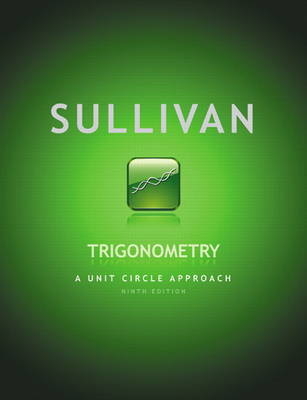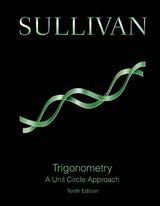
Trigonometry
Pearson (Verlag)
978-0-321-71657-6 (ISBN)
- Titel erscheint in neuer Auflage
- Artikel merken
Michael Sullivan, Emeritus Professor of Mathematics at Chicago State University, received a Ph.D. in mathematics from the Illinois Institute of Technology. Mike taught at Chicago State for 35 years before recently retiring. He is a native of Chicago’s South Side and divides his time between a home in Oak Lawn IL and a condo in Naples FL. Mike is a member of the American Mathematical Society and the Mathematical Association of America. He is a past president of the Text and Academic Authors Association and is currently Treasurer of its Foundation. He is a member of the TAA Council of Fellows and was awarded the TAA Mike Keedy award in 1997 and the Lifetime Achievement Award in 2007. In addition, he represents TAA on the Authors Coalition of America. Mike has been writing textbooks for more than 35 years and currently has 15 books in print, twelve with Pearson Education. When not writing, he enjoys tennis, golf, gardening, and travel. Mike has four children: Kathleen, who teaches college mathematics; Michael III, who also teaches college mathematics, and who is his coauthor on two precalculus series; Dan, who is a sales director for Pearson Education; and Colleen, who teaches middle-school and secondary school mathematics. Twelve grandchildren round out the family.
1. Graphs and Functions
1.1 The Distance and Midpoint Formulas
1.2 Graphs of Equations; Circles
1.3 Functions and Their Graph
1.4 Properties of Functions
1.5 Library of Functions; Piecewise-defined Functions
1.6 Graphing Techniques: Transformations
1.7 One-to-One Functions; Inverse Functions
Chapter Review
Chapter Test
Chapter Projects
2. Trigonometric Functions
2.1 Angles and Their Measure
2.2 Trigonometric Functions: Unit Circle Approach
2.3 Properties of the Trigonometric Functions
2.4 Graphs of the Sine and Cosine Functions
2.5 Graphs of the Tangent, Cotangent, Cosecant, and Secant Functions
2.6 Phase Shift; Sinusoidal Curve Fitting
Chapter Review
Chapter Test
Cumulative Review
Chapter Projects
3. Analytic Trigonometry
3.1 The Inverse Sine, Cosine, and Tangent Functions
3.2 The Inverse Trigonometric Functions (continued)
3.3 Trigonometric Equations
3.4 Trigonometric Identities
3.5 Sum and Difference Formulas
3.6 Double-Angle and Half-Angle Formulas
3.7 Product-to-Sum and Sum-to-Product Formulas
Chapter Review
Chapter Test
Cumulative Review
Chapter Projects
4. Applications of Trigonometric Functions
4.1 Right Triangle Trigonometry; Applications
4.2 Law of Sines
4.3 Law of Cosines
4.4 Area of a Triangle
4.5 Simple Harmonic Motion; Damped Motion; Combining Waves
Chapter Review
Chapter Test
Cumulative Review
Chapter Projects
5. Polar Coordinates; Vectors
5.1 Polar Coordinates
5.2 Polar Equations and Graphs
5.3 The Complex Plane; DeMoivre’s Theorem
5.4 Vectors
5.5 The Dot Product
5.6 Vectors in Space
5.7 The Cross Product
Chapter Review
Chapter Test
Cumulative Review
Chapter Projects
6. Analytic Geometry
6.1 Conics
6.2 The Parabola
6.3 The Ellipse
6.4 The Hyperbola
6.5 Rotation of Axes; General Form of a Conic
6.6 Polar Equations of Conics
6.7 Plane Curves and Parametric Equations
Chapter Review
Chapter Test
Cumulative Review
Chapter Projects
7. Exponential and Logarithmic Functions
7.1 Exponential Functions
7.2Logarithmic Functions
7.3 Properties of Logarithms
7.4 Logarithmic and Exponential Equations
7.5 Financial Models
7.6 Exponential Growth and Decay Models; Newton’s Law; Logistic Growth and Decay Models
7.7 Building Exponential, Logarithmic, and Logistic Models from Data
Chapter Review
Chapter Test
Cumulative Review
Chapter Projects
Appendix A. Review
A.1 Algebra Essentials
A.2 Geometry Essentials
A.3 Factoring Polynomials; Completing the Square
A.4 Solving Equations
A.5 Complex Numbers; Quadratic Equations in the Complex Number System
A.6 Interval Notation; Solving Inequalities
A.7 nth Roots; Rational Exponents; Radical Equations
A.8 Lines
A.9 Building Linear Models from Data
Appendix B. Graphing Utilities
B.1 The Viewing Rectangle
B.2 Using a Graphing Utility to Graph Equations
B.3 Using a Graphing Utility to Locate Intercepts and Check for Symmetry
B.4 Using a Graphing Utility to Solve Equations
B.5 Square Screens
B.6 Using a Graphing Utility to Graph a Polar Equation
B.7 Using a Graphing Utility to Graph Parametric Equations
| Erscheint lt. Verlag | 9.11.2011 |
|---|---|
| Sprache | englisch |
| Maße | 216 x 279 mm |
| Gewicht | 1774 g |
| Themenwelt | Mathematik / Informatik ► Mathematik ► Analysis |
| Mathematik / Informatik ► Mathematik ► Geometrie / Topologie | |
| ISBN-10 | 0-321-71657-4 / 0321716574 |
| ISBN-13 | 978-0-321-71657-6 / 9780321716576 |
| Zustand | Neuware |
| Haben Sie eine Frage zum Produkt? |
aus dem Bereich



